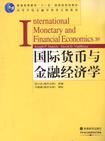国际货币与金融经济学
出版时间:2005-3 出版社:蓝色畅想 作者:丹尼尔斯 页数:999 译者:成君潞 注解
Tag标签:无
前言
自教育部在《关于加强高等学校本科教学工作提高教学质量的若干意见》【教高(2001)4号】中提出双语教学的要求后,各地高校相继开设了一系列双语教学课程。这对提高学生的学科和外文水平,开阔国际视野,培养创新型人才起到了重要的作用;一大批教师也逐渐熟悉了外文授课,自身的教学水平和能力得到较大提高,具备国际学术思维的中青年教师脱颖而出。同时,经过近几年的双语教学实践,国外原版教材量大、逻辑不够清晰、疏离中国现实等问题也影响了双语教学的效果。因此,对外版教材进行本土化的精简改编,使之更加适合我国的双语教学已提上教材
内容概要
《国际货币与金融经济学》系统而深入浅出地介绍了国际金融所涉及的所有主题。全书包括五个部分,共15章。其中,第一和第二部分介绍了国际货币金融交易活动的支付和交易体系以及主要的国际金融工具、市场和金融机构;第三部分主要论述了汇率和国际收支的决定;第四和第五部分主要是开放宏观经济学和政策分析,包括世界经济中的一国和多国的政策制定。
作者简介
约瑟夫R丹尼尔斯,JosephRDaniels),美国马奎特大学经济系和国际商务系副教授,曾先后在印第安纳大学、多伦多大学任教,多次获得教学奖励奖,主要研究领域是汇率制度、国际货币与金融政策等。戴维D.范胡斯,DavidD.VanHoose),美国贝勒大学的经济学教授和Hemanw.Lav私人企业讲习教授,拥有20多年的教学经验。他在许多一流金融经济杂志,如QuarterlvJournalofEconomics,InternationalEconomicReview,JournalofMoney,Credit,andBanking等发表论文若干篇,并分别在1991年获得JournalofBankingandFinance的杰出论文奖,在1995和2001年获得AtlanticEconomicJournal的最佳论文奖。范小云,经济学博士,南开大学金融学系副教授,现任南开大学国际金融研究中心主任、金融学系副主任。在《国际金融研究》、《经济学动态》等刊物发表文章近20篇。主要研究方向为国际金融、金融风险、货币理论与货币政策等。马君潞,经济学博士,南开大学经济学院副院长、金融学系主任、教授、博士生导师。主要研究方向为国际金融、货币理论与货币政策、公司财务等。
书籍目录
UNIT 1: INTERNATIONAL PAYMENTS AND EXCHANGECHAPTER 1KEEPING UP WITH A CHANGING WORLDTRADE FLOWS, CAPITAL FLOWS,ANDTHE BALANCE OF PAYMENTS2International Economic Integration: The Importance of Global Trade and Financial Markets3The Real and Financial Sectors of an Economy3World Trade in Goods and Services4InternationaITransactions in Financial Assets6The Balance of Payments8Balance of Payments as a Double-EntryBookkeeping System9Balance of Payments Accounts10Deficits and Surpluses in the Balanceof Payments14Other Deficit and Surplus Measures15The Capital Account and the International Flow of Assets16A CapitalAccount Surplus17The United States as a Net Debtor17Relating the Current Account Balance and Capital Flows18Chapter Summary20Questions and Problems21CHAPTER 2THE MARKET FOR FOREIGN EXCHANGE23Exchange Rates and the Market for ForeignExchange24The Role of the Foreign Exchange Market24Exchange Rates as Relative Prices26Bid-Ask Spreads and Trading Margins28Real Exchange Rates29The Effect of Price Changes30Measuring the Overall Strength or Weaknessof a Currency: Effective Exchange Rates31Constructing an Effective Exchange Rate32A Two-Country Example of an Effective ExchangeRate33Composite Currencies35Special Drawing Right (SDR)35Foreign Exchange Arbitrage36The Demand for and Supply of Currencies38The Demand for a Currency38The Supply of a Currency39The Equilibrium Exchange Rate41Foreign Exchange Market Intervention42Purchasing Power Parity44Absolute Purchasing Power Parity44POLICY NOTEBOOK: The Big Mac Index48Relative Purchasing Power Parity49Chapter Summary 51Questions and Problems52CHAPTER 3EXCHANGE-RATE SYSTEMS, PASTTO PRESENT54Exchange-Rate Systems55The Gold Standard56The Gold Standard as an Exchange-RateSystem56Performance of the Gold Standard57The Collapse of the Gold Standard59The Bretton Woods System60The Bretton Woods Agreement60Performance of the Bretton Woods System62The Flexible-Exchange-Rate System65The Economic Summits and a New Order65Performance of the Floating-Rate System66The Plaza Agreement and the Louvre Accord67The Euro 68Other Forms of Exchange-Rate ArrangementsToday69Crawling Pegs70Currency Baskets71Independent Currency Authorities73Dollarization73Fixed or Floating Exchange Rates?75Should China Peg or Float?76Chapter Summary 81Questions and Problems82UNIT 2: INTERNATIONAL FINANCIAL INSTRUMENTS, MARKETS,AND INSTITUTIONSCHAPTER 4THE FORWARD CURRENCY MARKETAND INTERNATIONAL FINANCIALARBITRAGE 84Foreign Exchange Risk84Types of Foreign Exchange Risk Exposure85Hedging Foreign Exchange Risk 86The Forward Exchange Market87Covering a Transaction with a Forward Contract87Determination of Forward Exchange Rates88The Forward Exchange Rate as a Predictor of the Future Spot Rate89International Financial Arbitrage91Interest Parity91Exchange Uncertainty and Covered Interest Parity92Uncovered Interest Parity94Uncovered Interest Arbitrage94Risk and Uncovered Interest Parity95Risks Other than Foreign Exchange Risk96Tests of Uncovered Interest Parity96Foreign Exchange Market Efficiency97Market Efficiency98Evidence on Foreign Exchange Market Efficiency98International Financial Markets98International Capital Markets99International Money Markets99Eurobonds, Euronotes, and Eurocommercial Paper99Eurocurrencies100Chapter Summary103Questions and Problems103CHAPTER 5INTEREST YIELDS, INTEREST-RATE RISK, AND DERIVATIVE SECURITIES106Interest Yields and Financial Instrument Prices106Interest Rate Differentials-Excess Returns and Failure of Uncovered Interest Parity108Breakdown of Uncovered Interest Parity and Excess Returns109MANAGEMENT NOTEBOOK: Why Uncovered Interest Parity May Hold, but Not for Very Long110Accounting for Differences in Excess Returns to Help Explain International Interest Rate Differences111Real Interest Rates and Real Interest Parity113Real Interest Parity114Hedging, Speculation, and Derivative Securities116Possible Responses to Interest-Rate Risk116Derivative Securities117Common Derivative Securities and Their Risks121Forward Contracts121Futures122Options126Swaps133Derivatives Risks and Regulation135Chapter Summary137Questions and Problems138CHAPTER 6INTERNATIONAL BANKING, CENTRALBANKS, AND SUPRANATIONAL FINANCIALPOLICYMAKING INSTITUTIONS140Financial Intermediation Across NationalBoundaries141Banking Around the Globe142Bank versus Market Finance142Differences in Bank Market Structure143A New Convergence: Universal Banking143Global Payments and Financial SystemRisks144Global Payment Systems145Payment-System Risks146Financial Instability and International FinancialCrises150POLICY NOTEBOOK: Using "Exchange Market Pressures" to Assess Contagion Effects152Bank Regulation and Capital Requirements154The Goals of Bank Regulation154Bank Capital Requirements155Supranational Financial Policymaking Institutions159The International Monetary Fund159The World Bank162Chapter Summary164Questions and Problems165CHAPTER 7THE INTERNATIONAL FINANCIAL ARCHITECTURE AND EMERGINGECONOMIES 166International Capital Flows167Explaining the Direction of Capital Flows167Capital Allocations and Economic Growth173Capital Misallocations and Their Consequences175Maximizing Benefits and Minimizing Risks176Where Do Financial Intermediaries Fit In?177Capital Market Liberalization and Intemational Financial Crises178Are All Capital Flows Equal?178The Role of Capital Flows in Recent Crisis Episodes180Exchange Rate Regimes and Financial Crises182Schools of Thought on Exchange Rate Regimes 182The Corners Hypothesis183Dollarization183Peg, Take the Middle Road, or Float?184Evaluating the Status Quo185Does the International Financial Architecture Need a Redesign?187Crisis Prediction and Early Warning Systems187Rethinking Economic Institutions and Policies189Chapter Summary191Questions and Problems192UNIT 3: EXCHANGE-RATE AND BALANCE-OF-PAYMENTSDETERMINATIONCHAPTER 8TRADITIONAL APPROACHES TO BALANCE OF-PAYMENTS AND EXCHANGE-RATE DETERMINATION 195Common Characteristics of the Traditional Approaches196Exports, Imports, and the Demand for and Supply of Foreign Exchange196Derivation of the Demand for Foreign Exchange196Elasticity and the Demand for Foreign Exchange 198Derivation of the Supply of Foreign Exchange 200Elasticity and the Supply of Foreign Exchange200The Elasticities Approach202The Exchange Rate and the Balance of Payments 202Short- and Long-Run Elasticity Measures and the J-Curve 206Pass-Through Effects208The Absorption Approach209Modeling the Absorption Approach 209Determination of the Current Account Balance210Economic Expansion and Contraction211Policy Instruments213Chapter Summary 214Questions and Problems 215CHAPTER 9MONETARY AND PORTFOLIO APPROACHESTO BALANCE-OF-PAYMENTS AND EXCHANGE-RATE DETERMINATION 217 Central Bank Balance Sheets 218Managed Exchange Rates: Foreign Exchange Interventions218Mechanics of Foreign Exchange Interventions218Foreign Exchange Interventions and the Money Stock219Sterilization of Interventions219The Monetary Approach to Balance-of-Payments and Exchange-Rate Determination221The Cambridge Approach to Money Demand221Money, the Balance of Payments, and the Exchange Rate221The Monetary Approach and a Fixed-Exchange-Rate Arrangement223The Monetary Approach and a Flexible-Exchange Rate Arrangement225Applying the Monetary Approach: A Two-Country Setting227ATwo-Country Monetary Model227The Portfolio Approach to Exchange-Rate Determination228Households' Allocation of Wealth229To Sterilize or Not to Sterilize?232Do Interventions Accomplish Anything?233Chapter Summary235Questions and Problems236……UNIT 4: OPEN ECONOMY MACROECONOMICS AND POLICY ANALYSISUNIT 5: DOMESTIC AND MULTINATIONAL POLICYMAKING IN A GLOBAL ECONOMY
章节摘录
插图:
编辑推荐
《国际货币与金融经济学》学术水平高、内容丰富、理论密切联系实际,适合作为经济类和金融类专业"国际金融"程双语教学的高年级本科生教材和研究生教材,作为MBA相关课程的教材也颇为适宜,对于实际工作者和对国际金融感兴趣的人士,也是很好的参考书。
图书封面
图书标签Tags
无
评论、评分、阅读与下载
用户评论 (总计8条)
- 这本书是根据国内实际情况,在原版基础上进行了适当的修改和调整的!如果要是想买这位作者的书,我个人建议买影印版本!
- 文字表达很难理解,语句复杂,需要花时间思考字面意思~
- 相比国内的国际金融学教材来说,这本书真的很不错 讲得很好
- 很好啊,是正版,比学校便宜一点,就是发货有点慢
- 书的目录编排得很好,只看目录的话,觉得是一本非常好的教材。但深入里面一看,发现很多错误。究其原因,可能是改编者截取不当造成的,而且越到后面问题越多,到最后三章发现没法按教材讲了。中国的作(编)者总想在短时间内出大量成果,事实证明不靠谱……
- 已经等待好久了,书本不错啊。字迹清淅,是正版啊~
- 不错哦 送货非常及时呢
- 纸张有点黄 但是总体还不错
